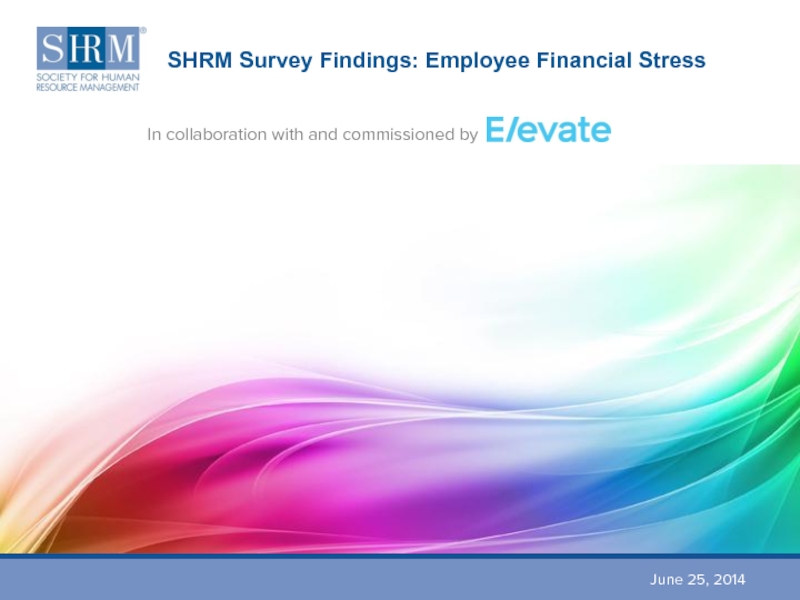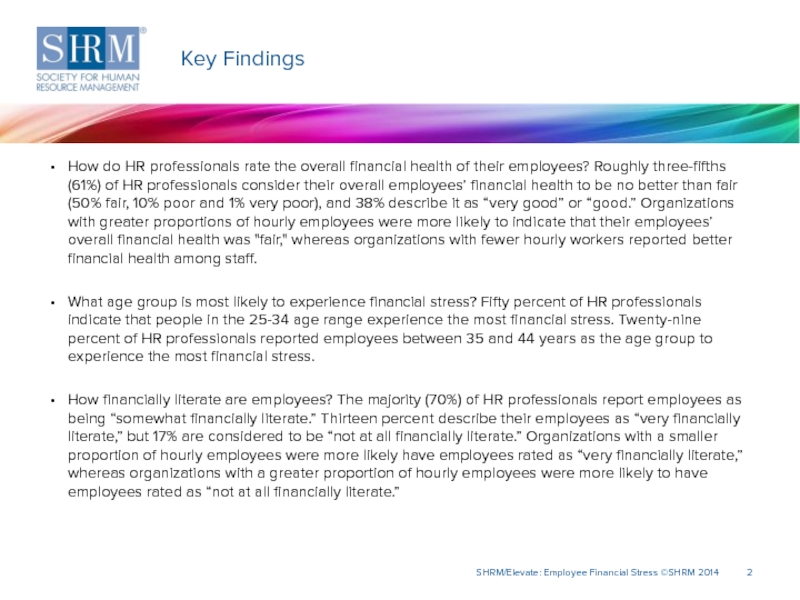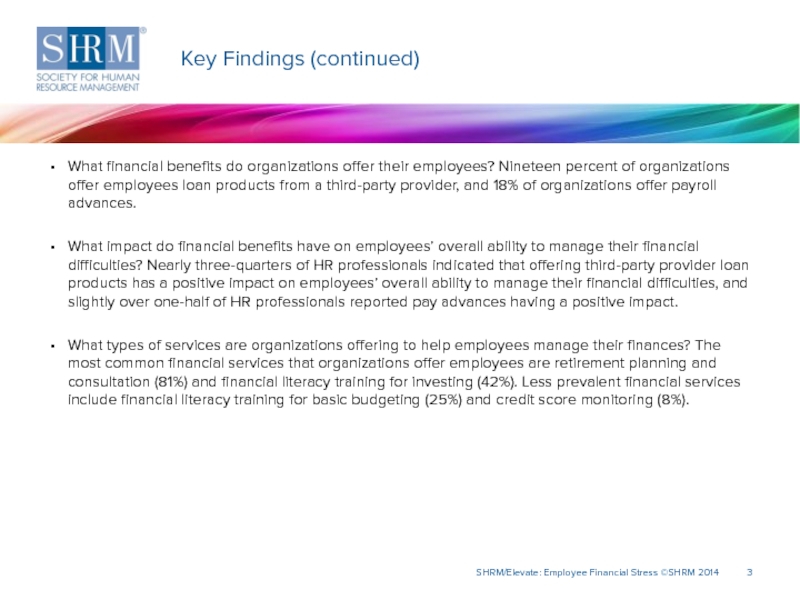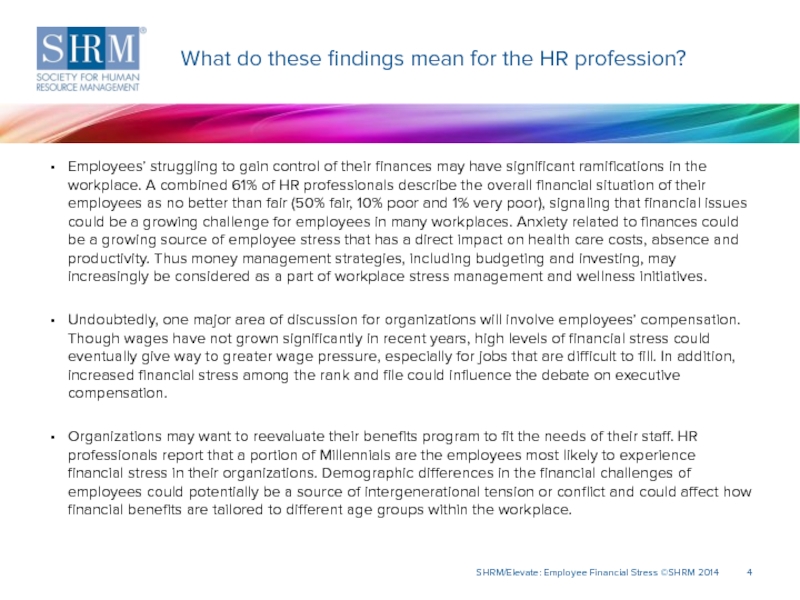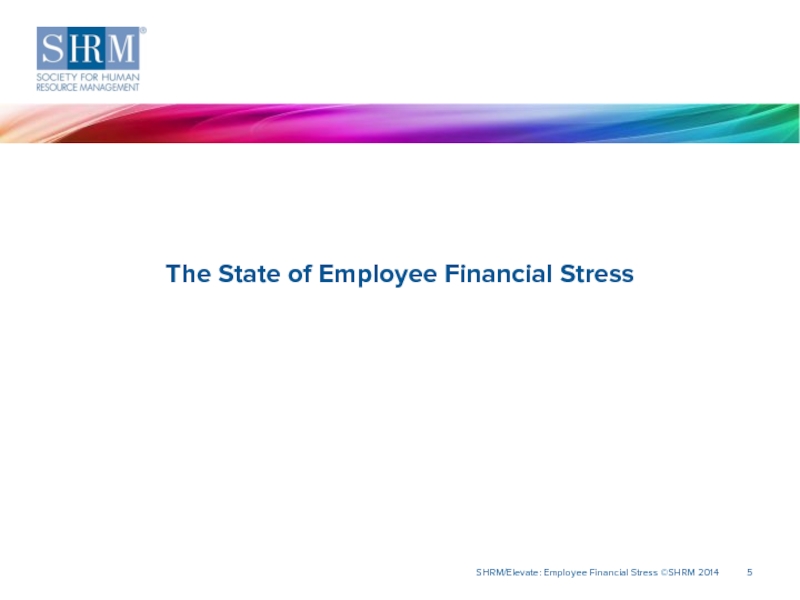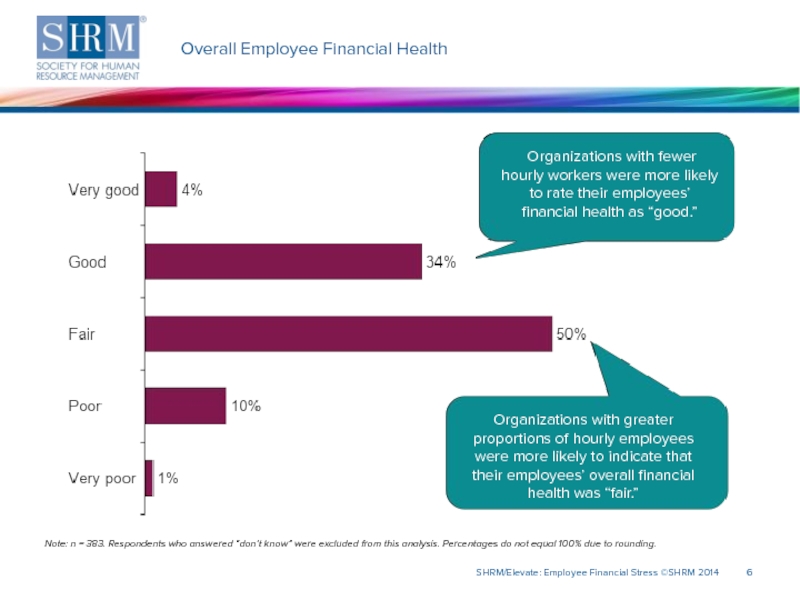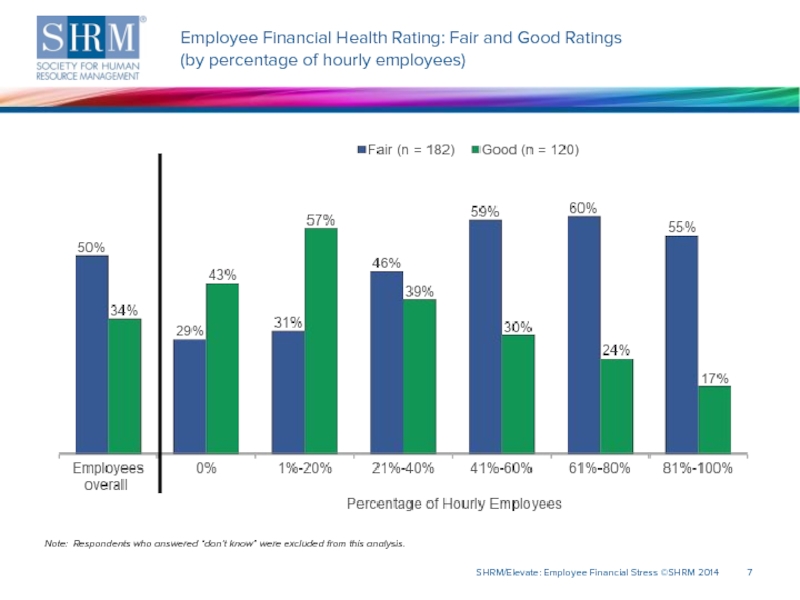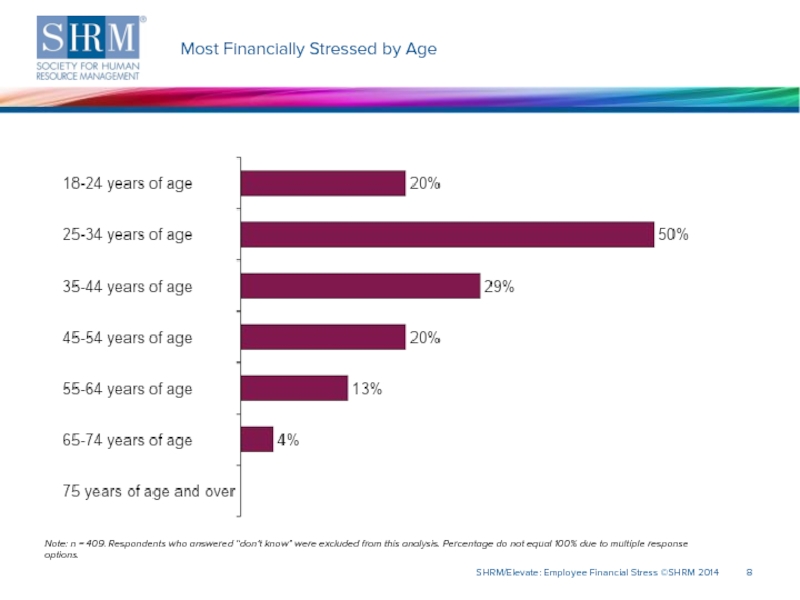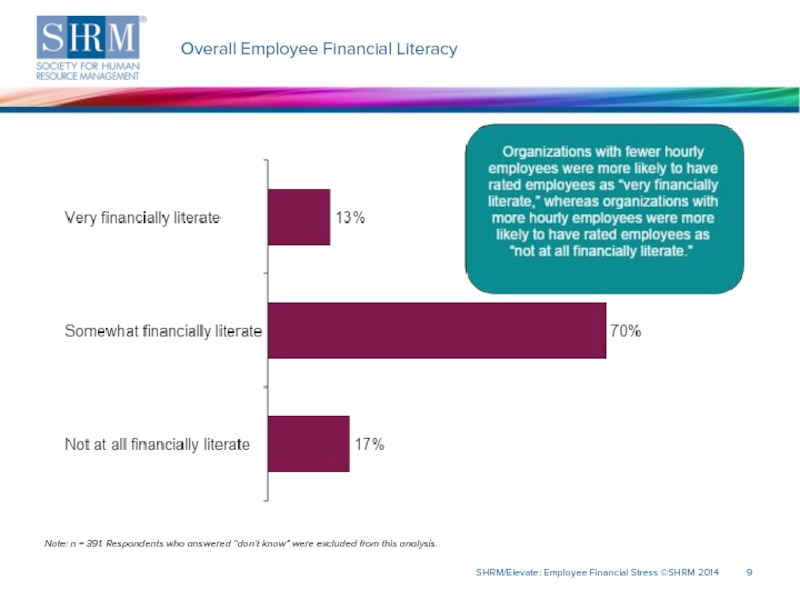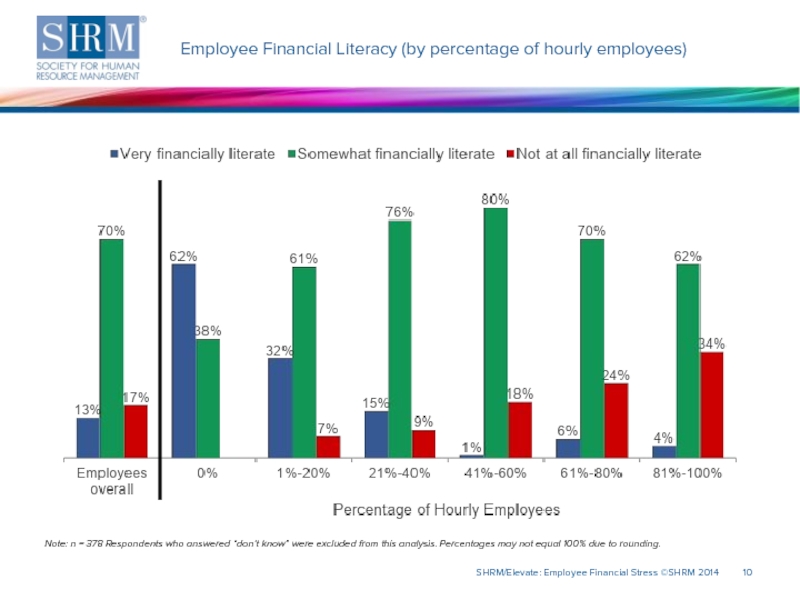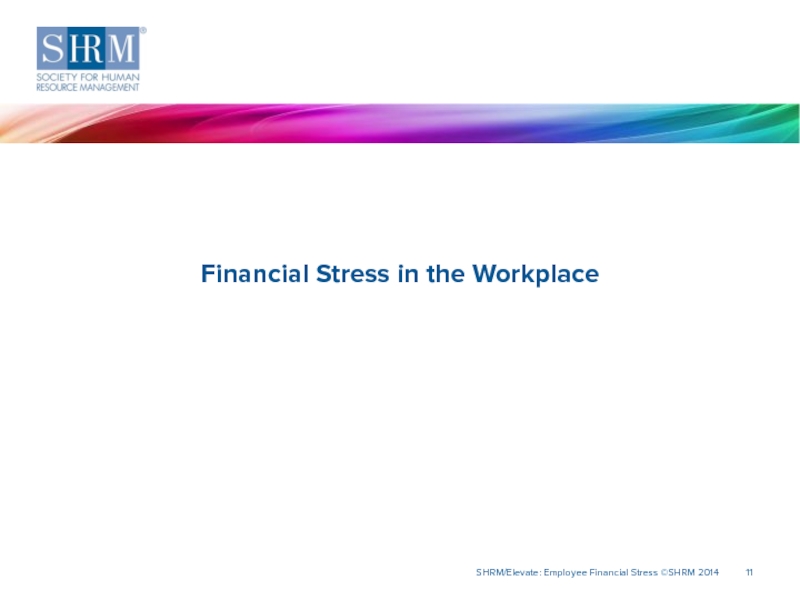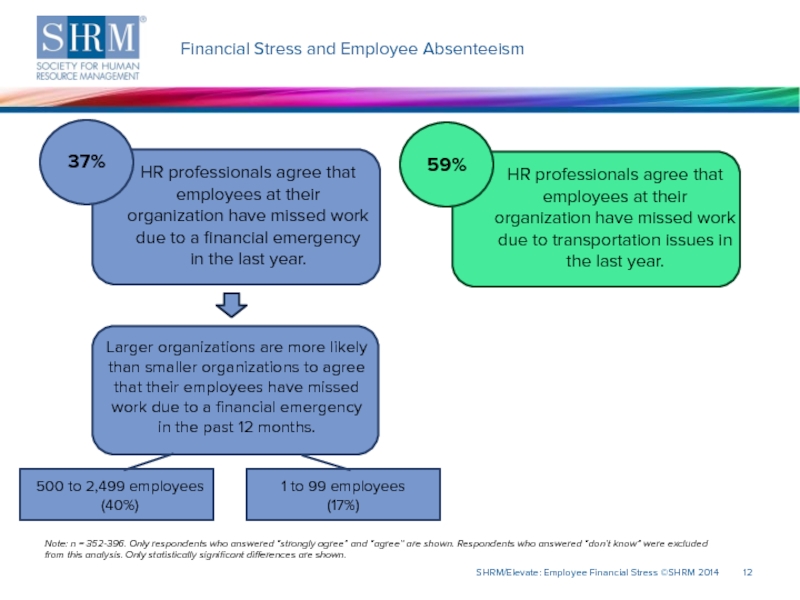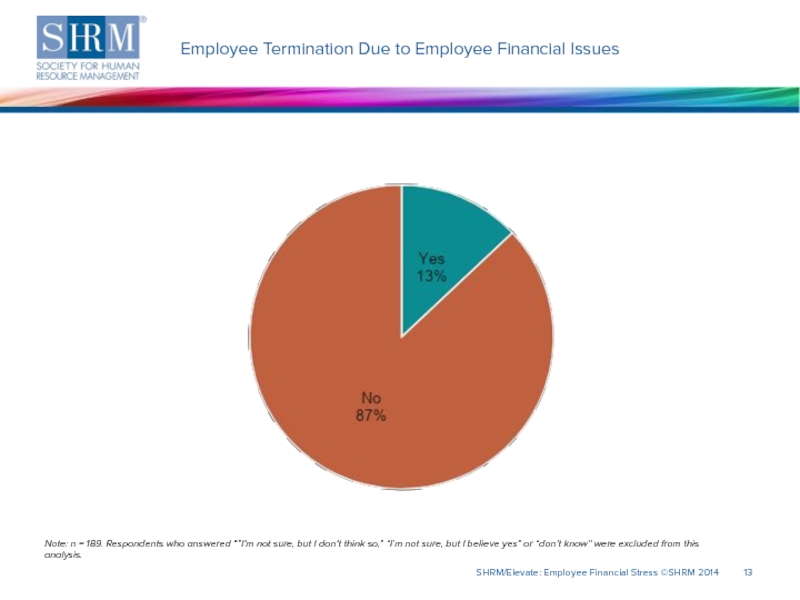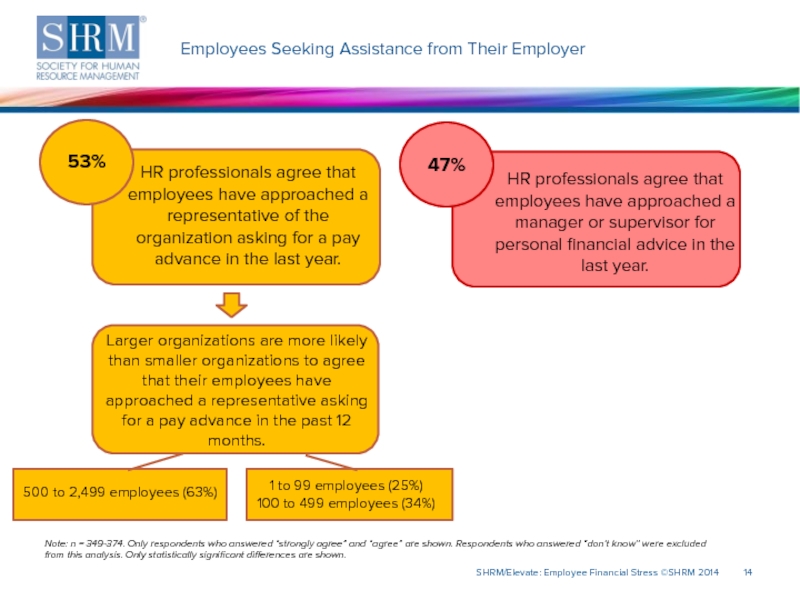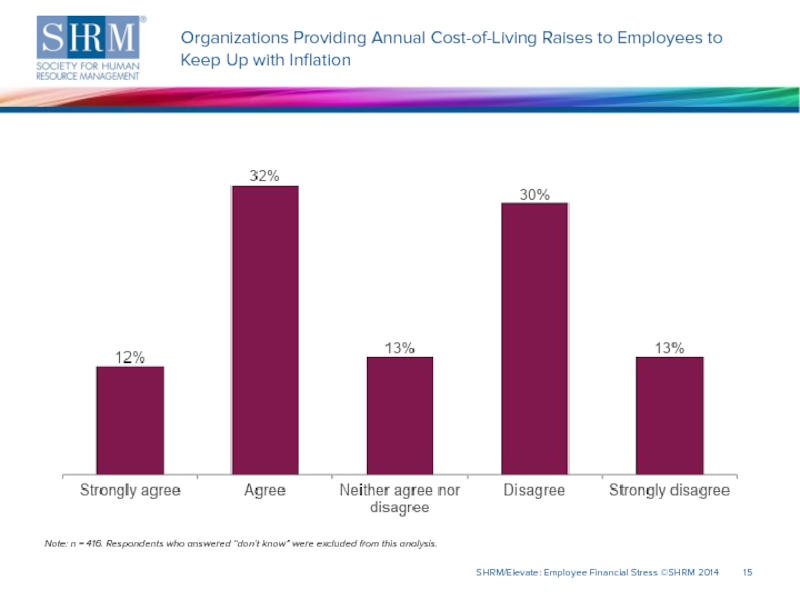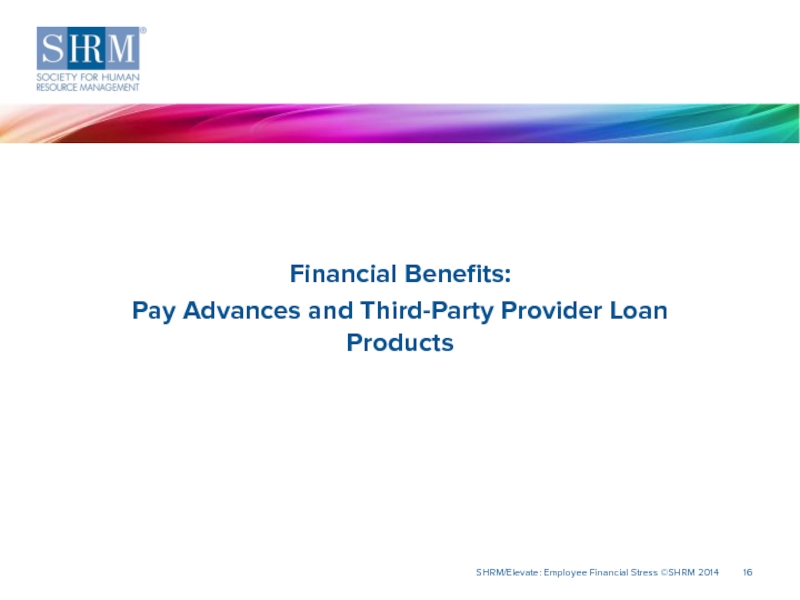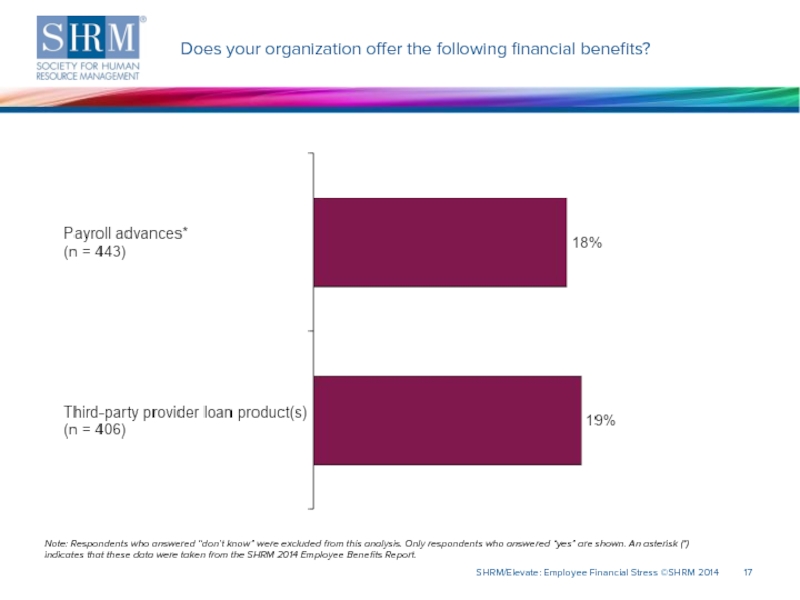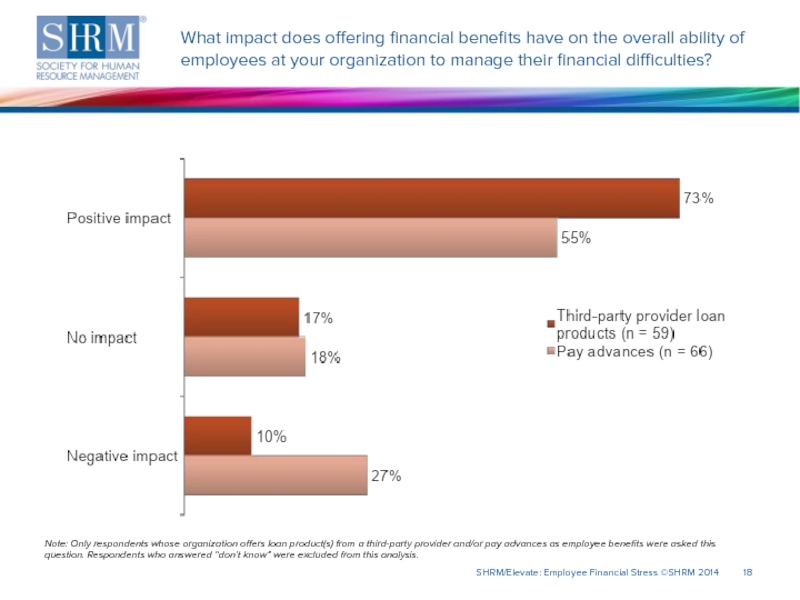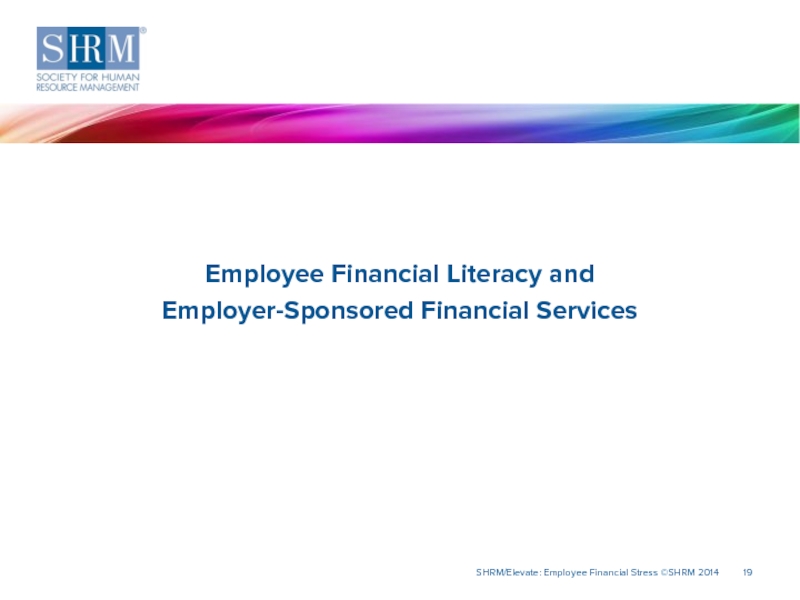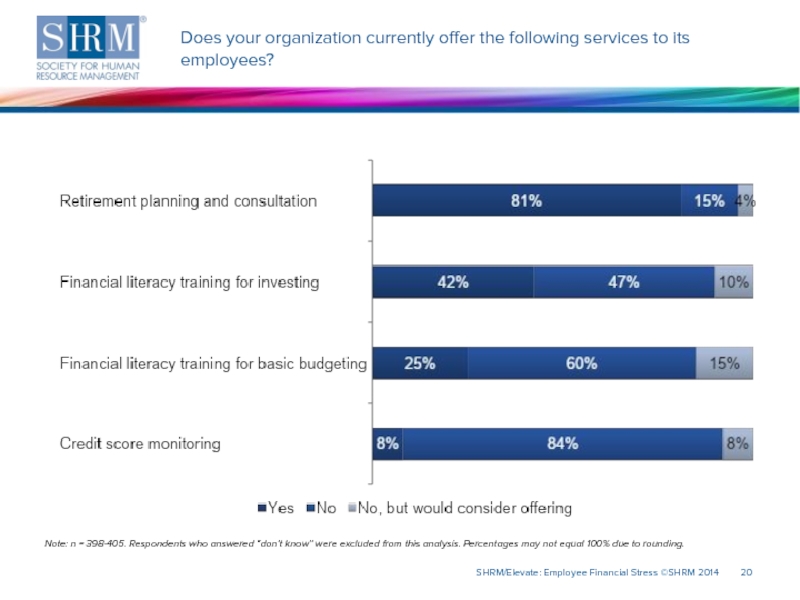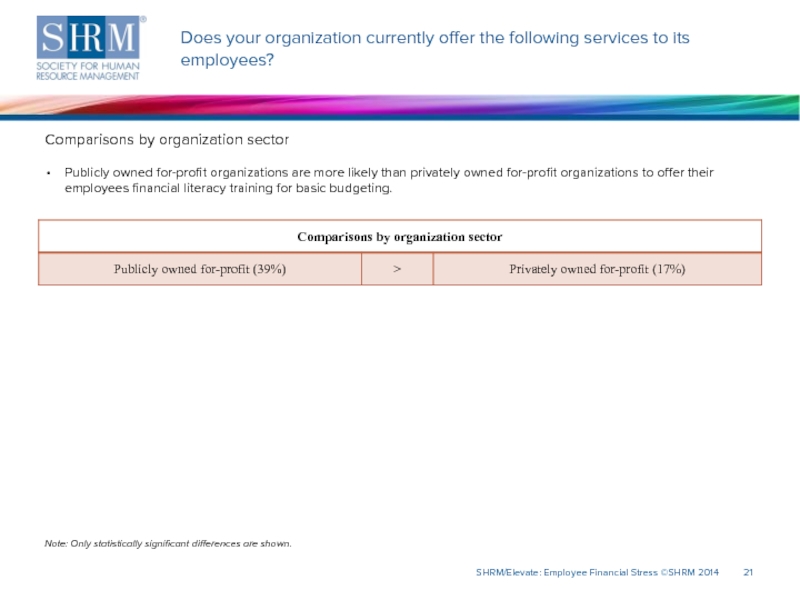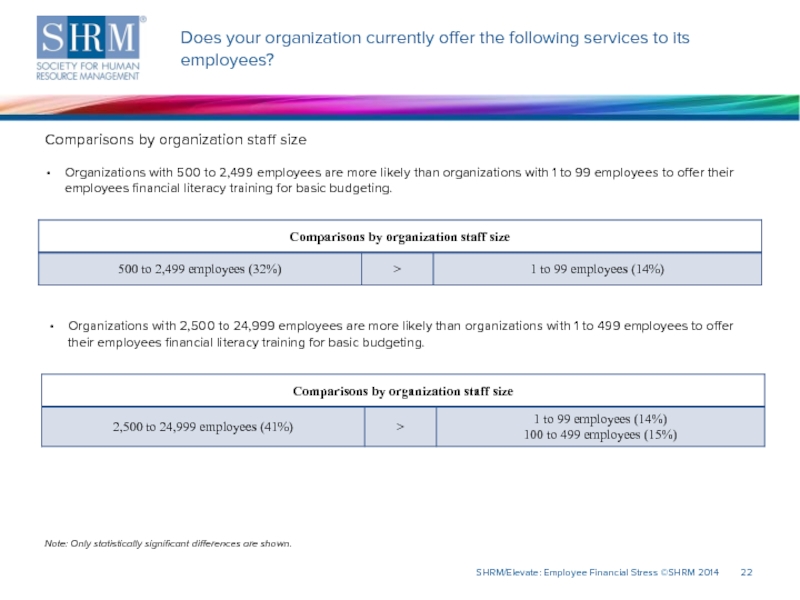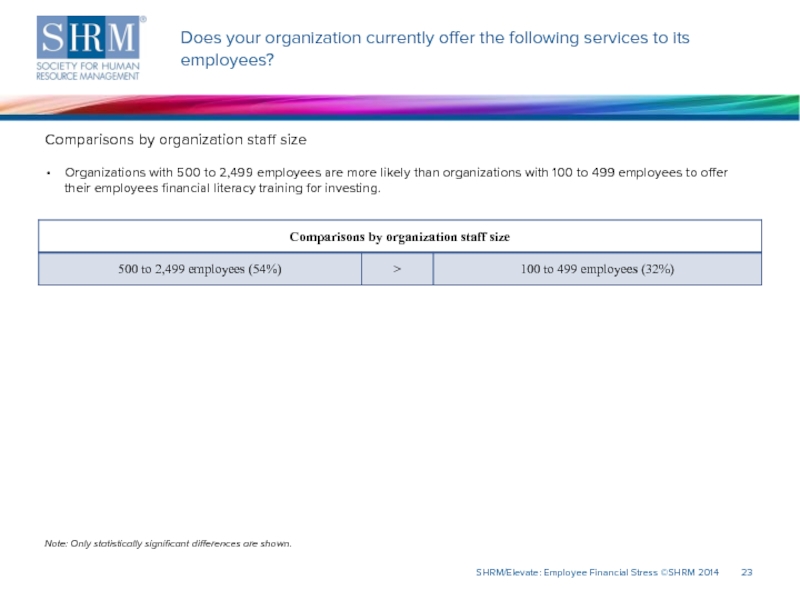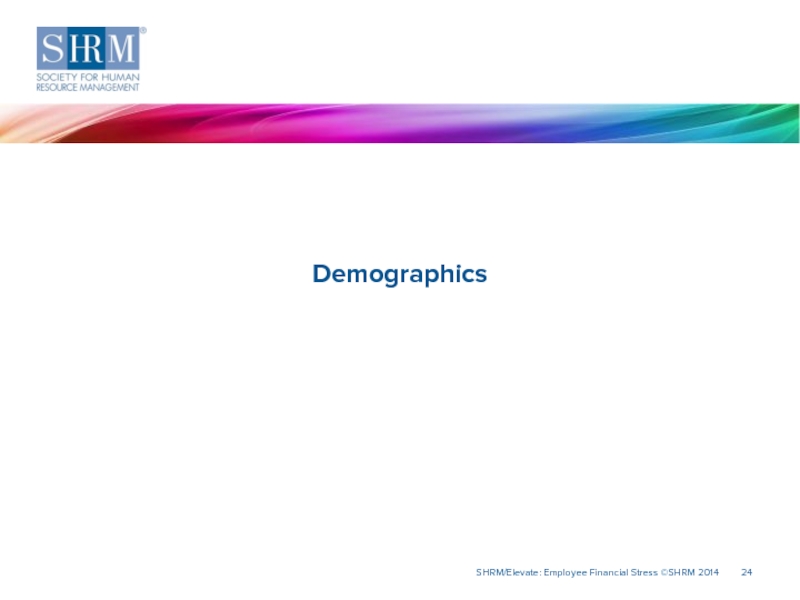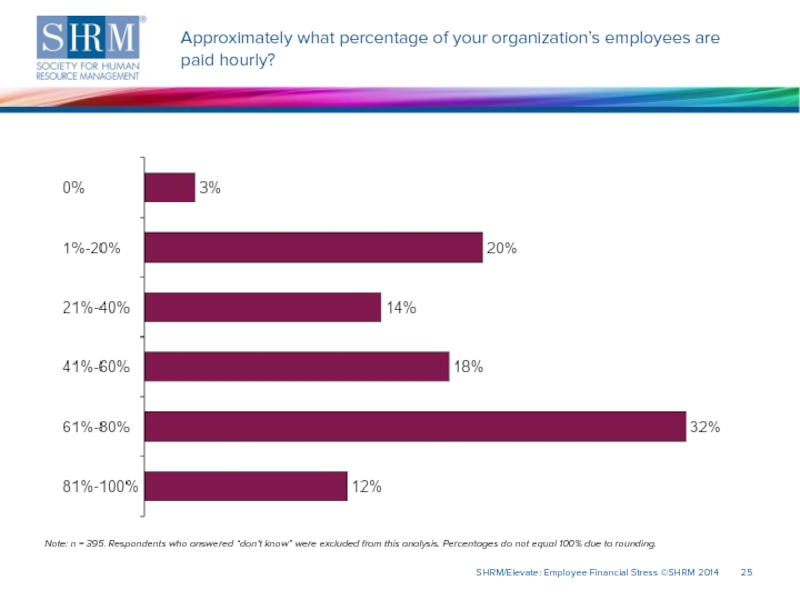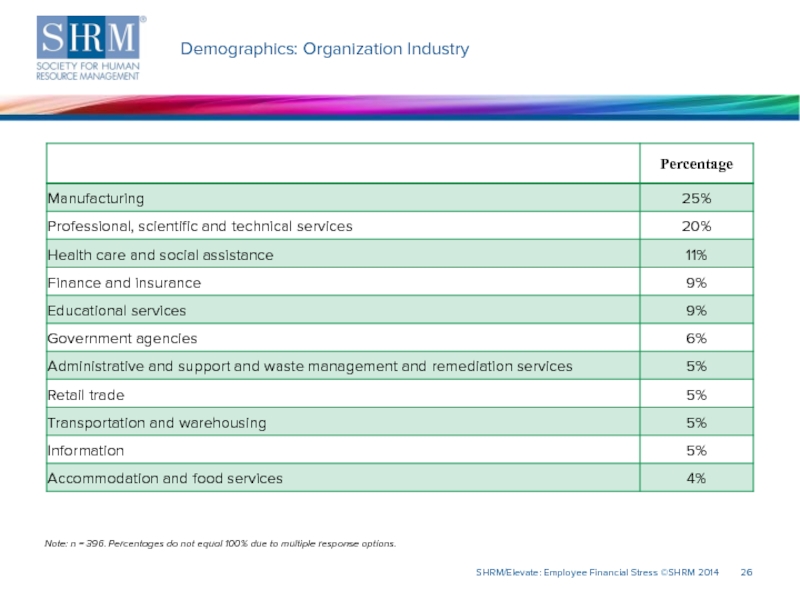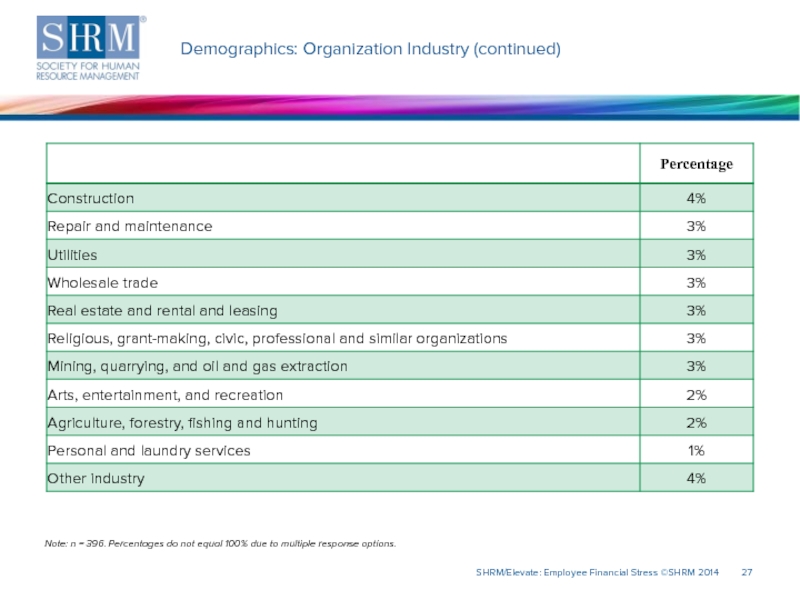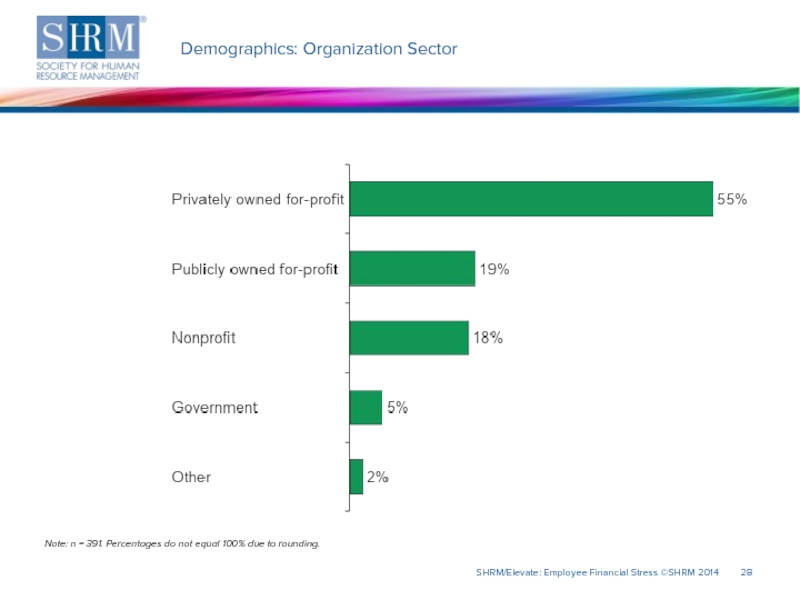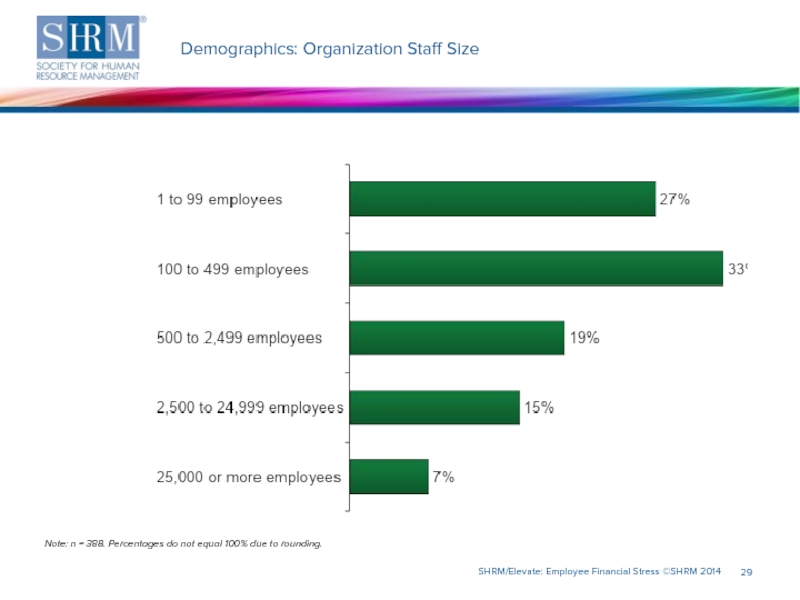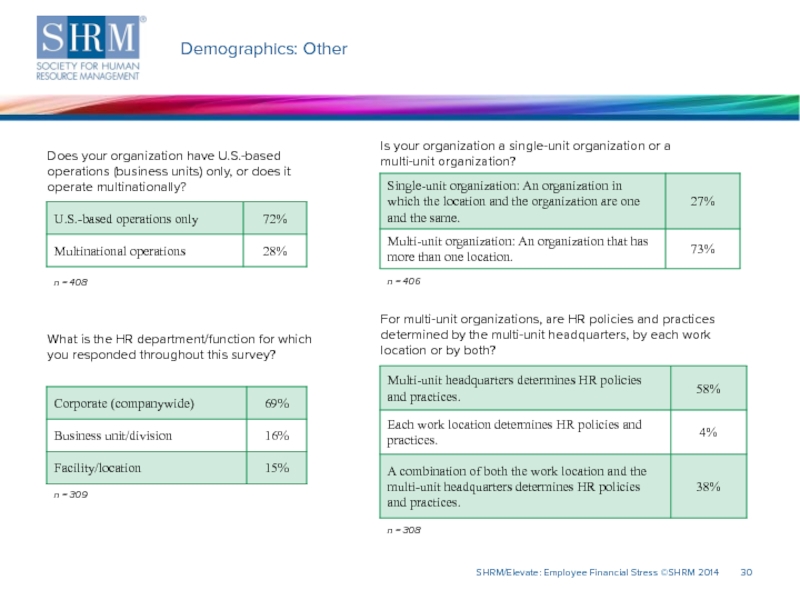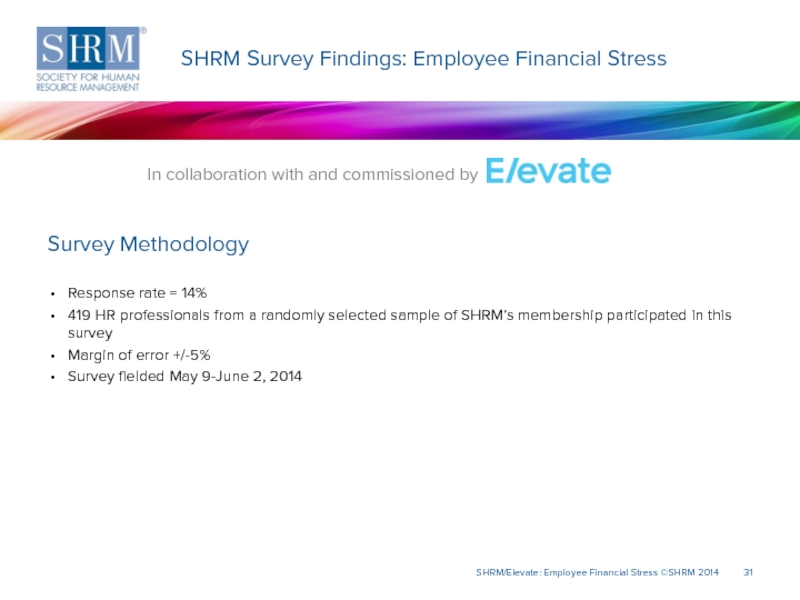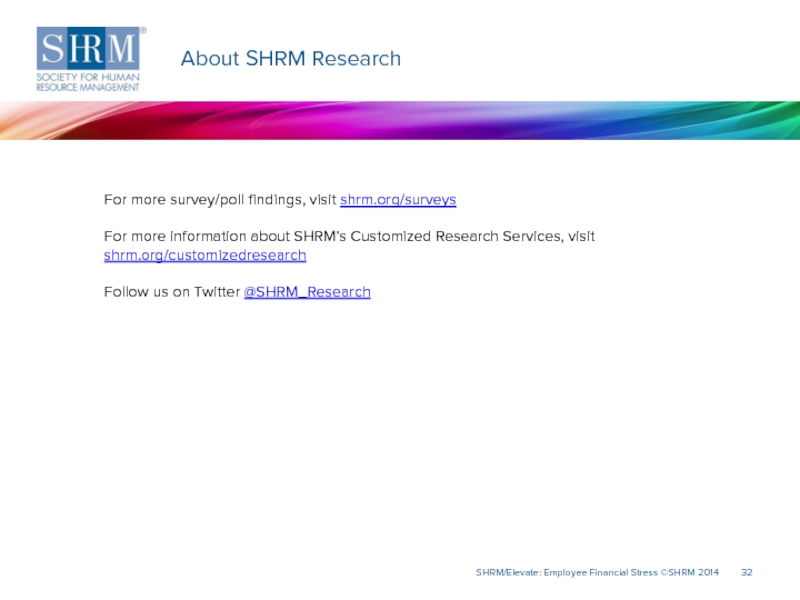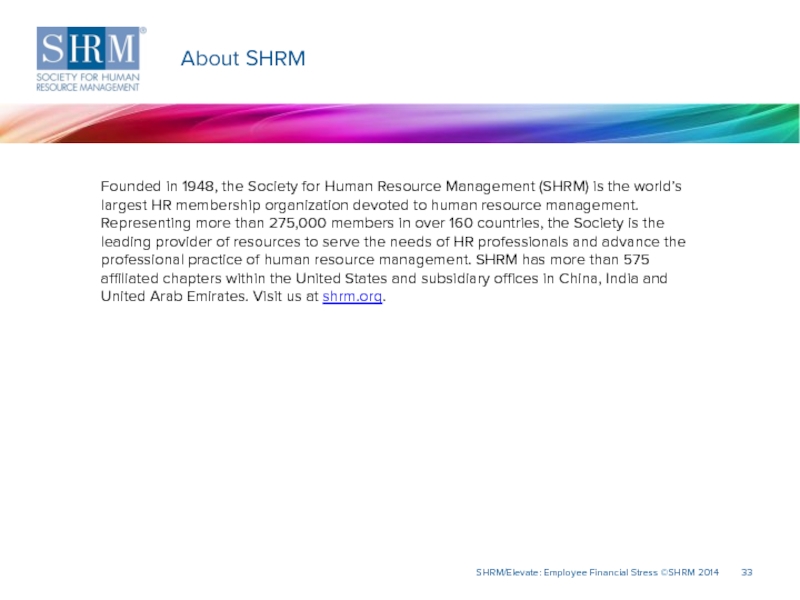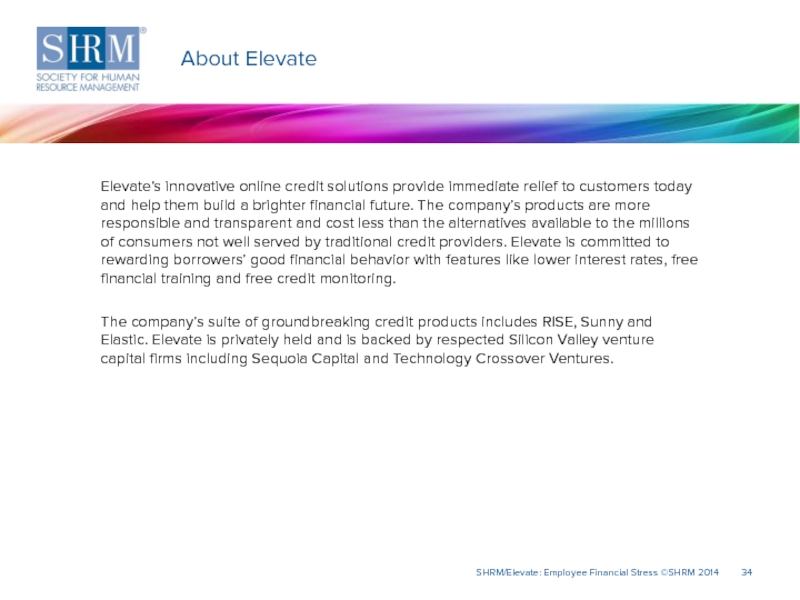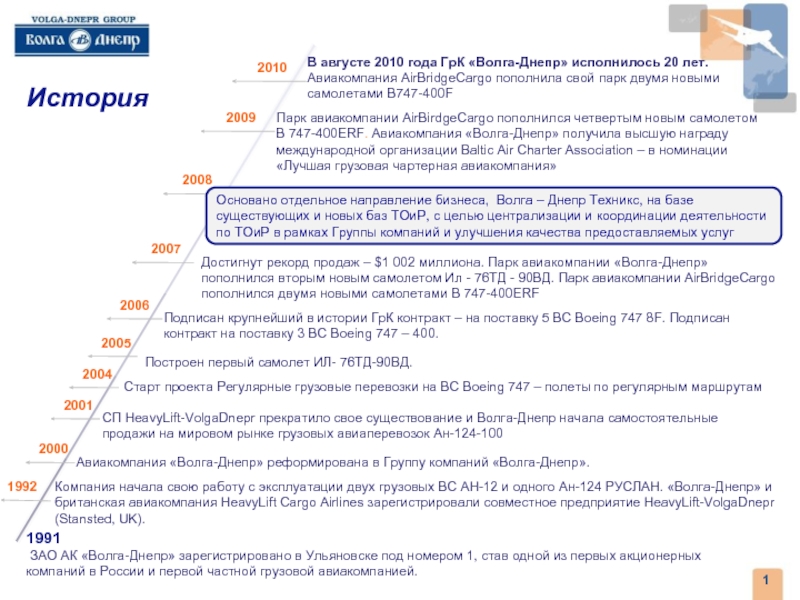- Главная
- Разное
- Дизайн
- Бизнес и предпринимательство
- Аналитика
- Образование
- Развлечения
- Красота и здоровье
- Финансы
- Государство
- Путешествия
- Спорт
- Недвижимость
- Армия
- Графика
- Культурология
- Еда и кулинария
- Лингвистика
- Английский язык
- Астрономия
- Алгебра
- Биология
- География
- Детские презентации
- Информатика
- История
- Литература
- Маркетинг
- Математика
- Медицина
- Менеджмент
- Музыка
- МХК
- Немецкий язык
- ОБЖ
- Обществознание
- Окружающий мир
- Педагогика
- Русский язык
- Технология
- Физика
- Философия
- Химия
- Шаблоны, картинки для презентаций
- Экология
- Экономика
- Юриспруденция
SHRM Survey Findings: Employee Financial Stress презентация
Содержание
- 1. SHRM Survey Findings: Employee Financial Stress
- 2. How do HR professionals rate the overall
- 3. What financial benefits do organizations offer their
- 4. Employees’ struggling to gain control of their
- 5. SHRM/Elevate: Employee Financial Stress ©SHRM 2014 The State of Employee Financial Stress
- 6. Overall Employee Financial Health SHRM/Elevate: Employee
- 7. Employee Financial Health Rating: Fair and Good
- 8. Most Financially Stressed by Age SHRM/Elevate: Employee
- 9. Overall Employee Financial Literacy SHRM/Elevate: Employee Financial
- 10. Employee Financial Literacy (by percentage of hourly
- 11. SHRM/Elevate: Employee Financial Stress ©SHRM 2014 Financial Stress in the Workplace
- 12. Financial Stress and Employee Absenteeism SHRM/Elevate: Employee
- 13. Employee Termination Due to Employee Financial Issues
- 14. Employees Seeking Assistance from Their Employer SHRM/Elevate:
- 15. Organizations Providing Annual Cost-of-Living Raises to Employees
- 16. SHRM/Elevate: Employee Financial Stress ©SHRM 2014 Financial
- 17. Does your organization offer the following financial
- 18. What impact does offering financial benefits have
- 19. SHRM/Elevate: Employee Financial Stress ©SHRM 2014 Employee Financial Literacy and Employer-Sponsored Financial Services
- 20. Does your organization currently offer the following
- 21. Does your organization currently offer the following
- 22. Does your organization currently offer the following
- 23. Does your organization currently offer the following
- 24. SHRM/Elevate: Employee Financial Stress ©SHRM 2014 Demographics
- 25. Approximately what percentage of your organization’s employees
- 26. Demographics: Organization Industry SHRM/Elevate: Employee Financial Stress
- 27. Demographics: Organization Industry (continued) SHRM/Elevate: Employee Financial
- 28. Demographics: Organization Sector SHRM/Elevate: Employee Financial Stress
- 29. Demographics: Organization Staff Size SHRM/Elevate: Employee Financial
- 30. n = 408 Demographics: Other SHRM/Elevate:
- 31. SHRM Survey Findings: Employee Financial Stress Response
- 32. For more survey/poll findings, visit shrm.org/surveys
- 33. Founded in 1948, the Society for Human
- 34. Elevate’s innovative online credit solutions provide immediate
Слайд 1SHRM Survey Findings: Employee Financial Stress
In collaboration with and commissioned by
June
Слайд 2How do HR professionals rate the overall financial health of their
What age group is most likely to experience financial stress? Fifty percent of HR professionals indicate that people in the 25-34 age range experience the most financial stress. Twenty-nine percent of HR professionals reported employees between 35 and 44 years as the age group to experience the most financial stress.
How financially literate are employees? The majority (70%) of HR professionals report employees as being “somewhat financially literate.” Thirteen percent describe their employees as “very financially literate,” but 17% are considered to be “not at all financially literate.” Organizations with a smaller proportion of hourly employees were more likely have employees rated as “very financially literate,” whereas organizations with a greater proportion of hourly employees were more likely to have employees rated as “not at all financially literate.”
SHRM/Elevate: Employee Financial Stress ©SHRM 2014
Key Findings
Слайд 3What financial benefits do organizations offer their employees? Nineteen percent of
What impact do financial benefits have on employees’ overall ability to manage their financial difficulties? Nearly three-quarters of HR professionals indicated that offering third-party provider loan products has a positive impact on employees’ overall ability to manage their financial difficulties, and slightly over one-half of HR professionals reported pay advances having a positive impact.
What types of services are organizations offering to help employees manage their finances? The most common financial services that organizations offer employees are retirement planning and consultation (81%) and financial literacy training for investing (42%). Less prevalent financial services include financial literacy training for basic budgeting (25%) and credit score monitoring (8%).
SHRM/Elevate: Employee Financial Stress ©SHRM 2014
Key Findings (continued)
Слайд 4Employees’ struggling to gain control of their finances may have significant
Undoubtedly, one major area of discussion for organizations will involve employees’ compensation. Though wages have not grown significantly in recent years, high levels of financial stress could eventually give way to greater wage pressure, especially for jobs that are difficult to fill. In addition, increased financial stress among the rank and file could influence the debate on executive compensation.
Organizations may want to reevaluate their benefits program to fit the needs of their staff. HR professionals report that a portion of Millennials are the employees most likely to experience financial stress in their organizations. Demographic differences in the financial challenges of employees could potentially be a source of intergenerational tension or conflict and could affect how financial benefits are tailored to different age groups within the workplace.
SHRM/Elevate: Employee Financial Stress ©SHRM 2014
What do these findings mean for the HR profession?
Слайд 6Overall Employee Financial Health
SHRM/Elevate: Employee Financial Stress ©SHRM 2014
Note: n
Organizations with greater proportions of hourly employees were more likely to indicate that their employees’ overall financial health was “fair.”
Organizations with fewer hourly workers were more likely to rate their employees’ financial health as “good.”
Слайд 7Employee Financial Health Rating: Fair and Good Ratings (by percentage of hourly
SHRM/Elevate: Employee Financial Stress ©SHRM 2014
Note: Respondents who answered “don’t know” were excluded from this analysis.
Слайд 8Most Financially Stressed by Age
SHRM/Elevate: Employee Financial Stress ©SHRM 2014
Note: n
Слайд 9Overall Employee Financial Literacy
SHRM/Elevate: Employee Financial Stress ©SHRM 2014
Note: n =
Слайд 10Employee Financial Literacy (by percentage of hourly employees)
SHRM/Elevate: Employee Financial Stress
Note: n = 378 Respondents who answered “don’t know” were excluded from this analysis. Percentages may not equal 100% due to rounding.
Слайд 12Financial Stress and Employee Absenteeism
SHRM/Elevate: Employee Financial Stress ©SHRM 2014
Note: n
59%
HR professionals agree that employees at their organization have missed work due to transportation issues in the last year.
37%
HR professionals agree that employees at their organization have missed work due to a financial emergency in the last year.
Larger organizations are more likely than smaller organizations to agree that their employees have missed work due to a financial emergency in the past 12 months.
500 to 2,499 employees (40%)
1 to 99 employees
(17%)
Слайд 13Employee Termination Due to Employee Financial Issues
SHRM/Elevate: Employee Financial Stress ©SHRM
Note: n = 189. Respondents who answered “”I’m not sure, but I don’t think so,” “I’m not sure, but I believe yes” or “don’t know” were excluded from this analysis.
Слайд 14Employees Seeking Assistance from Their Employer
SHRM/Elevate: Employee Financial Stress ©SHRM 2014
Note:
47%
HR professionals agree that employees have approached a manager or supervisor for personal financial advice in the last year.
53%
HR professionals agree that employees have approached a representative of the organization asking for a pay advance in the last year.
Larger organizations are more likely than smaller organizations to agree that their employees have approached a representative asking for a pay advance in the past 12 months.
500 to 2,499 employees (63%)
1 to 99 employees (25%)
100 to 499 employees (34%)
Слайд 15Organizations Providing Annual Cost-of-Living Raises to Employees to Keep Up with
SHRM/Elevate: Employee Financial Stress ©SHRM 2014
Note: n = 416. Respondents who answered “don’t know” were excluded from this analysis.
Слайд 16SHRM/Elevate: Employee Financial Stress ©SHRM 2014
Financial Benefits:
Pay Advances and Third-Party
Слайд 17Does your organization offer the following financial benefits?
SHRM/Elevate: Employee Financial Stress
Note: Respondents who answered “don’t know” were excluded from this analysis. Only respondents who answered “yes” are shown. An asterisk (*) indicates that these data were taken from the SHRM 2014 Employee Benefits Report.
Слайд 18What impact does offering financial benefits have on the overall ability
SHRM/Elevate: Employee Financial Stress ©SHRM 2014
Note: Only respondents whose organization offers loan product(s) from a third-party provider and/or pay advances as employee benefits were asked this question. Respondents who answered “don’t know” were excluded from this analysis.
Слайд 19SHRM/Elevate: Employee Financial Stress ©SHRM 2014
Employee Financial Literacy and
Employer-Sponsored Financial
Слайд 20Does your organization currently offer the following services to its employees?
SHRM/Elevate:
Note: n = 398-405. Respondents who answered “don’t know” were excluded from this analysis. Percentages may not equal 100% due to rounding.
Слайд 21Does your organization currently offer the following services to its employees?
SHRM/Elevate:
Note: Only statistically significant differences are shown.
Comparisons by organization sector
Publicly owned for-profit organizations are more likely than privately owned for-profit organizations to offer their employees financial literacy training for basic budgeting.
Слайд 22Does your organization currently offer the following services to its employees?
SHRM/Elevate:
Note: Only statistically significant differences are shown.
Comparisons by organization staff size
Organizations with 500 to 2,499 employees are more likely than organizations with 1 to 99 employees to offer their employees financial literacy training for basic budgeting.
Organizations with 2,500 to 24,999 employees are more likely than organizations with 1 to 499 employees to offer their employees financial literacy training for basic budgeting.
Слайд 23Does your organization currently offer the following services to its employees?
SHRM/Elevate:
Note: Only statistically significant differences are shown.
Comparisons by organization staff size
Organizations with 500 to 2,499 employees are more likely than organizations with 100 to 499 employees to offer their employees financial literacy training for investing.
Слайд 25Approximately what percentage of your organization’s employees are paid hourly?
SHRM/Elevate:
Note: n = 395. Respondents who answered “don’t know” were excluded from this analysis. Percentages do not equal 100% due to rounding.
Слайд 26Demographics: Organization Industry
SHRM/Elevate: Employee Financial Stress ©SHRM 2014
Note: n = 396.
Слайд 27Demographics: Organization Industry (continued)
SHRM/Elevate: Employee Financial Stress ©SHRM 2014
Note: n =
Слайд 28Demographics: Organization Sector
SHRM/Elevate: Employee Financial Stress ©SHRM 2014
Note: n = 391.
Слайд 29Demographics: Organization Staff Size
SHRM/Elevate: Employee Financial Stress ©SHRM 2014
Note: n =
Слайд 30n = 408
Demographics: Other
SHRM/Elevate: Employee Financial Stress ©SHRM 2014
Is your
For multi-unit organizations, are HR policies and practices determined by the multi-unit headquarters, by each work location or by both?
Does your organization have U.S.-based operations (business units) only, or does it operate multinationally?
n = 406
n = 308
n = 309
What is the HR department/function for which you responded throughout this survey?
Слайд 31SHRM Survey Findings: Employee Financial Stress
Response rate = 14%
419 HR professionals
Margin of error +/-5%
Survey fielded May 9-June 2, 2014
In collaboration with and commissioned by
Survey Methodology
SHRM/Elevate: Employee Financial Stress ©SHRM 2014
Слайд 32For more survey/poll findings, visit shrm.org/surveys
For more information about SHRM’s Customized
Follow us on Twitter @SHRM_Research
SHRM/Elevate: Employee Financial Stress ©SHRM 2014
About SHRM Research
Слайд 33Founded in 1948, the Society for Human Resource Management (SHRM) is
SHRM/Elevate: Employee Financial Stress ©SHRM 2014
About SHRM
Слайд 34Elevate’s innovative online credit solutions provide immediate relief to customers today
The company’s suite of groundbreaking credit products includes RISE, Sunny and Elastic. Elevate is privately held and is backed by respected Silicon Valley venture capital firms including Sequoia Capital and Technology Crossover Ventures.
SHRM/Elevate: Employee Financial Stress ©SHRM 2014
About Elevate
